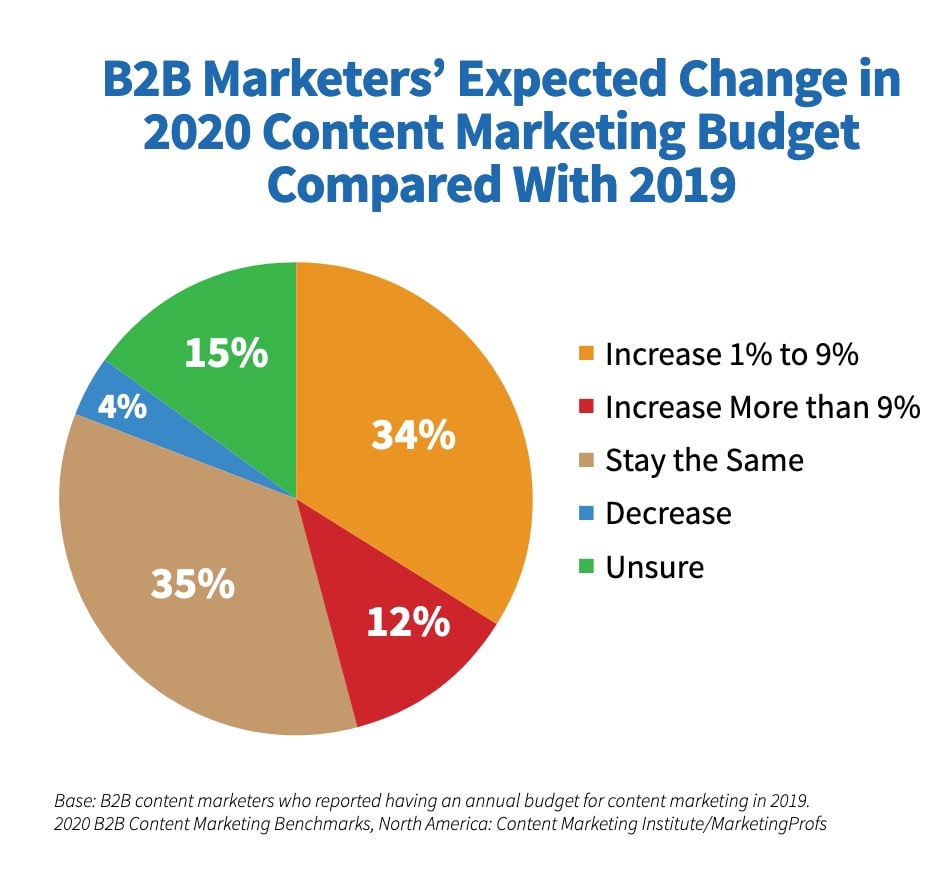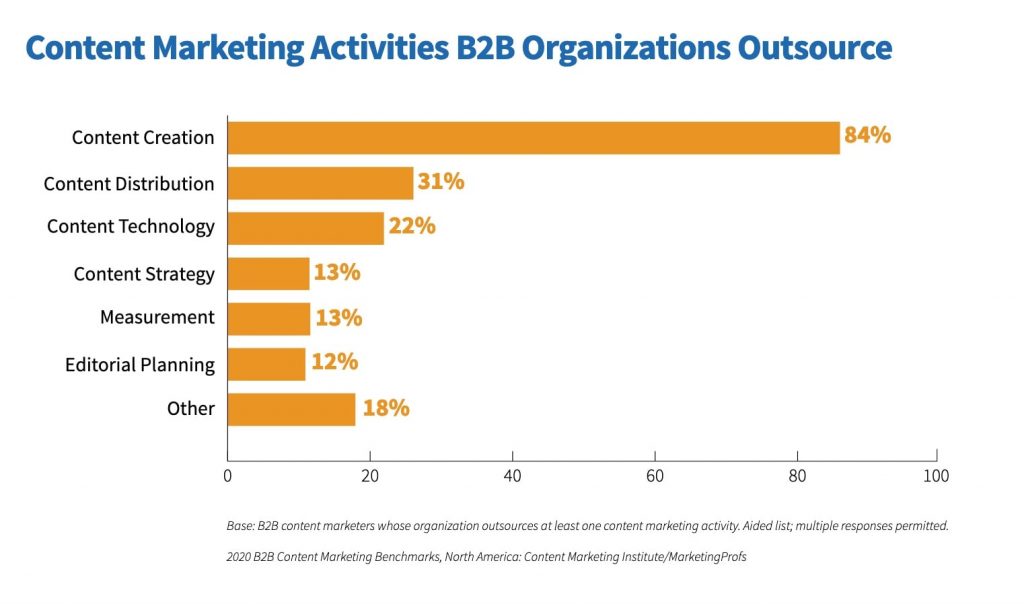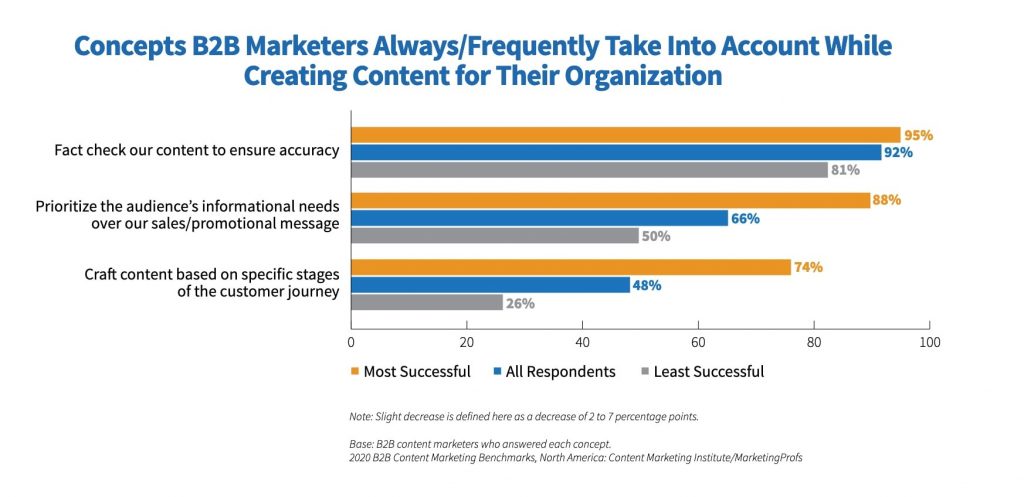For all the wonders of words to help us communicate, think more deeply, and convey truth, they have a dark side. I can just as easily write up a statement that’s a bald-faced lie as one that’s true. Or I can convey an idea that that’s inaccurate—maybe one I fully believe—in a way that makes it sound legitimate.

Stating something is easy. Backing up what you say with convincing evidence is harder. That’s why content marketing writing frequently includes statistics from research.
When to Use Statistics in Content Marketing
Statistics have an important role to play in good content writing. Any time you’re trying to make a point about something, backing it up with a statistic is one of the best ways to convince your reader of the accuracy of what you’re saying. Instead of stating “lots of people shop on their mobile devices”—which many readers will intuitively feel to be true—it’s more meaningful to say that “in 2020 mobile shopping makes up over 70% of ecommerce sales, according to Statista.”
Statistics aren’t the only way to back up a point with evidence, quotes from expert sources or anecdotes from case studies are also options, but they’re a strong tool content writers can use for making a compelling case.
How Not to Use Statistics in Content Marketing Writing
While statistics can be used to make a piece of content marketing writing more effective, they are often deployed lazily. Bad use of statistics is all over content marketing.
Some of the most common issues you’ll see are:
- Statistics that don’t include a link to the source.
If you don’t link back to a source, how is a reader supposed to know if the statistic is even real? I could say that 95% of businesses that hire freelance writers are happy with the results. That’s a statistic that would serve me, a freelance writer, pretty well. But I just made it up.
Anyone can make up a statistic that conveniently says what they want. In order for any reader with critical thinking skills to believe it, they need a way to check the claim themselves.
- Statistics that do link to a source, but not the original one.
Many content marketers will find a statistic that backs up the claim they’re making, and link back to where they found it. But if the article they found it in isn’t the original source, they’re still forcing work onto any reader that wants to check the stat.
Content marketers often end up in a game of virtual telephone, with different businesses linking to each other as the source of a particular statistic, making it difficult to find your way back to where the statistic came from to start. If a curious reader wants to verify the information and understand methodology and context, they’ll be disappointed if your link doesn’t take them to the original source.
- Source links that are broken.
This issue’s more understandable. Sometimes the originator of a piece of research will change the webpage it’s on, or remove it entirely after a few years. When that happens, everyone that cited that source ends up with broken links. I don’t assume sloppiness on the part of a brand when I encounter this, but it’s a good reminder to periodically update your content to keep it current.
- Statistics that are super old.
This is particularly an issue in topic areas where things change fast. A statistic about social media use from 2011 is basically worthless in 2020. Some of the most dominant social media platforms today didn’t even exist yet then, or were in their infancy. For any technological field, a statistic that’s more than a couple years old won’t adequately represent today’s reality. And even in other fields, statistics that are a few years old risk being inaccurate.
- Statistics provided without context (or that get the context wrong).
Sometimes in trying to make a statistic fit a particular point, writers leave out some of the context. That could mean saying 82% of people think something, when the research study the statistic came from was specific to marketers in the United States. U.S. marketers are people, to be sure, but it’s misleading to talk about a statistic that applies to a specific subset of the population as though it applies to everyone. Someone that doesn’t go back to check the original source in that case may believe something inaccurate based on how the information is presented. That does them a disservice.
How to Responsibly Use Statistics in Your Content Marketing
When you see so many other businesses perpetuating these errors, you may be tempted to do the same. If it’s the industry standard, why not take the easy route? But the world of content marketing is competitive, and your aim should be to do work that’s better than the norm, especially if it makes your writing more valuable to readers.
When using statistics, follow a few key rules to get it right.
1. Trace the statistic back to the original source.
Sometimes this is hard. You’ll find 20 articles all linking to each other, or back to an article that doesn’t explain where the number came from. In that case, don’t use the stat. You don’t know how old it is, so can’t be confident it’s not outdated. You can’t confirm the original source was reputable, or even that it wasn’t made up.
If you can’t can’t prove it’s legitimate, it’s not worth the risk of publishing bad information.
I make one main exception to this rule: if you manage to track a statistic back to a research paper that comes at a very high cost. Some companies charge handsomely for access to their research (think: hundreds or thousands of dollars per report). If you found a reputable source that cites that report, I believe it’s OK to go with that instead of the original.
2. Research the source.
If it’s not a brand or organization you’re already familiar with, do some research to find out what their reputation is. Misinformation online is far too common, and there are plenty of bad actors that intentionally put out misleading or erroneous information. You don’t want to inadvertently end up citing so-called research from a company or organization that’s out to deceive or manipulate.
3. Check the date.
If you’re in a fast-moving industry, try to find research less than a year old. In general, aim for research less than three years old. In some topic areas, older research may be fine. For example, if you’re writing about psychology, a study from ten years ago may still be worth mentioning. But if you’re writing about web design, a ten-year old statistic is worth little.
4. Check the methodology.
Legitimate research reports will provide some details on how they came to those numbers. If it was a survey, look for a page that explains who they contacted with the survey, how many people responded, and any relevant demographic information about the respondents.
If it was data compiled by software, then look for an explanation of the study’s sample size and how the data was compiled. For example, if a company publishes a research report about common web design elements created by having software scan different websites, they’d say how many websites were included, how they selected them, and any limitations of the process to be aware of.
You don’t have to explain the methodology when citing the statistic, but do take a minute to make sure the explanations are there so you can confirm the research is valid and that the stats are relevant to what you’re saying. If there’s a limitation in the methodology—e.g. the survey had a small group of respondents—do mention that. Start by seeing if you can find a better source. But if not, then make the limitations clear in your writing. For example, you could introduce the statistic with “While the sample size was small, one survey by Acme Corp found that <stat>”
5. Make sure you understand the context.
Sometimes what a statistic really means can get lost in the game of telephone between the original research report and the different articles written about it. The health field is particularly notorious for reporting that ditches any nuance in a research study to tout a statistic that makes for a good headline. But it’s not the only industry it happens in.
This may be tempting—it might get you clicks, or make your point look better supported than it really is—but it makes your writing less authoritative. Before you include a statistic in your writing, take time to make sure you understand it yourself. That’s a necessary step to keep from misrepresenting it.
6. Name the source in your piece.
Naming the source in the text of your piece tells readers right away where it comes from, without making them do more work. And if the webpage you link to moves or gets taken down (something all too common, as mentioned previously), it ensures readers still have some information on where the number came from.
So when saying “76% of all people like to eat chocolate” (a made-up stat), throw an “according to the Food Research Company” (a made-up source) before or after the statistic itself.
7. Link back to the (original) source.
Even though you’re working to make sure you’re presenting the statistic accurately, with the proper context, and with a mention of where it came from in the text, you still want to give your readers the means to check it all for themselves. A simple link back to the source does the trick.
8. Double-check the information before publishing.
Every writer knows how easily small errors can slip into pieces you’ve worked hard on. As part of your proofreading process, go back and double-check all the statistics you included in the piece. Make sure you didn’t mistype one, or get a couple mixed up. You don’t want to work hard to do everything the right way only to lose trust over a small error.
If Used Well, Statistics Can Make Your Writing Better
Using statistics badly is easy. That’s why it’s so common. Getting it right requires more work on a writer’s part. But if you want to create content marketing that’s trustworthy, that extra effort is worth it. And with how competitive content marketing is today, this is one way to make sure yours stands out as more valuable.



